
The True Business Value of the Agile Manifesto: From Philosophy to ROI
September 08, 2025 / Bryan Reynolds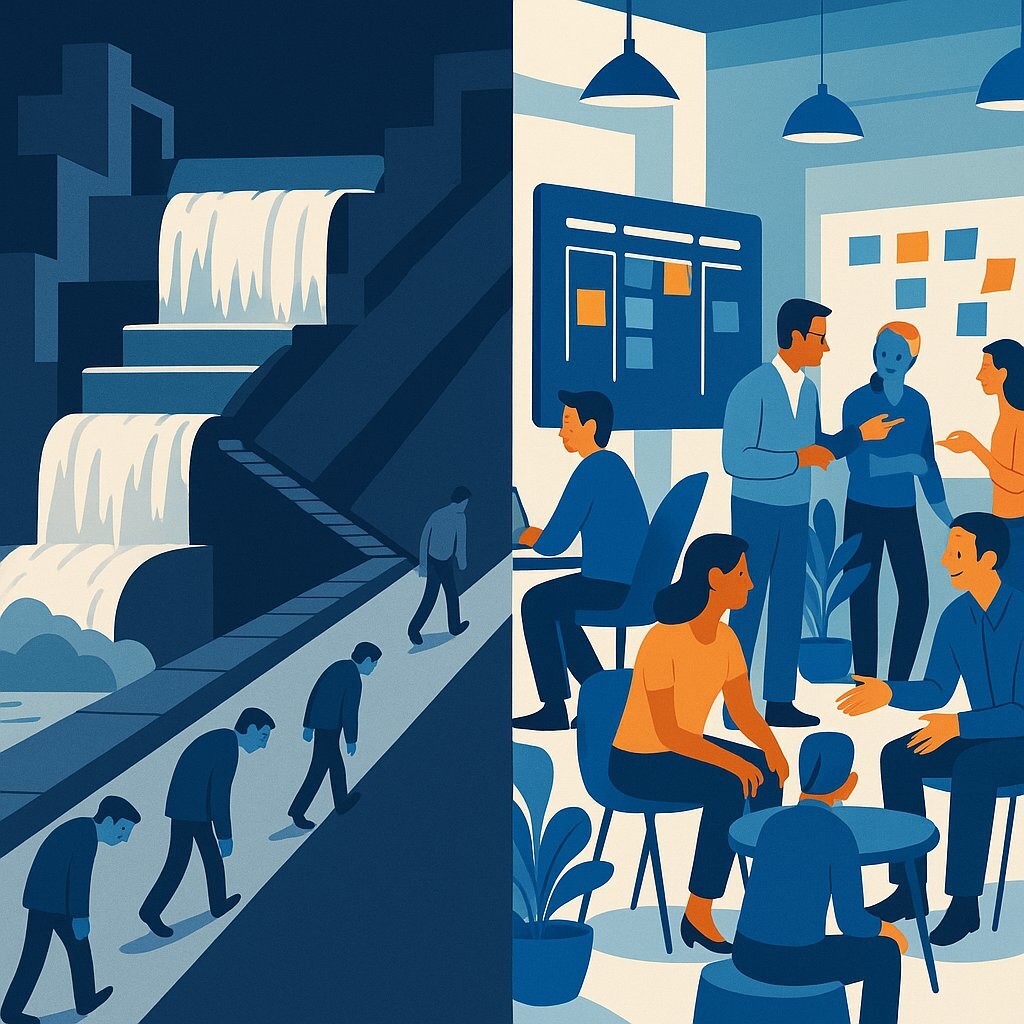
Imagine this: your company invests millions of dollars and 24 months into developing a groundbreaking piece of custom software. The project follows a meticulous, ironclad plan, with every requirement documented in a thousand-page binder. On launch day, the product is delivered exactly as specified. There's just one problem: in the two years it took to build, the market has shifted, your customers' needs have evolved, and a nimbler competitor has already captured the opportunity. The software, while technically perfect according to the original plan, is strategically obsolete on arrival.
This scenario, or a variation of it, has been the billion-dollar mistake of countless organizations. It's the predictable outcome of a rigid, industrial-era approach to the fluid, unpredictable work of software development. This was the exact problem a group of 17 software pioneers set out to solve in 2001, and their solution—a brief, 68-word document—would go on to revolutionize not just technology, but business itself.
That document was the Manifesto for Agile Software Development. But what was it really supposed to be? And more importantly, what does it mean for your business strategy and bottom line today? To answer that, we must first understand the world it was designed to replace. For decades, software was built using the "Waterfall" model—a linear, sequential process where each phase (requirements, design, build, test, deploy) must be fully completed before the next can begin. Like constructing a building, you can't start the second floor until the first is finished. This approach works for predictable work, but for the empirical, experimental nature of software, it created systemic business failures. Its core flaws were a direct threat to business success: extreme inflexibility to change, the discovery of costly errors only at the end of the project, and a near-total exclusion of the customer from the development process, leading to a final product that often missed the mark entirely.
The Agile Manifesto was not just a new process; it was a radical rethinking of how to create value and manage risk in the face of uncertainty.
What Was Agile Supposed to Be? A Rebellion Against Rigidity
In February 2001, seventeen software developers, engineers, and thought leaders gathered at The Lodge at Snowbird ski resort in Utah. They were a diverse group of "organizational anarchists" and proponents of various "lightweight methods" who shared a deep frustration with the state of their industry. They saw that companies had become so obsessed with excessively detailed plans, rigid processes, and comprehensive documentation that they had lost sight of their primary purpose: to solve problems and deliver value to their customers.
This meeting was a direct reaction against the heavyweight, bureaucratic Waterfall model that dominated the era. The core frustrations that fueled their conversation are the same ones that sink modern projects that fail to adopt a more adaptive approach:
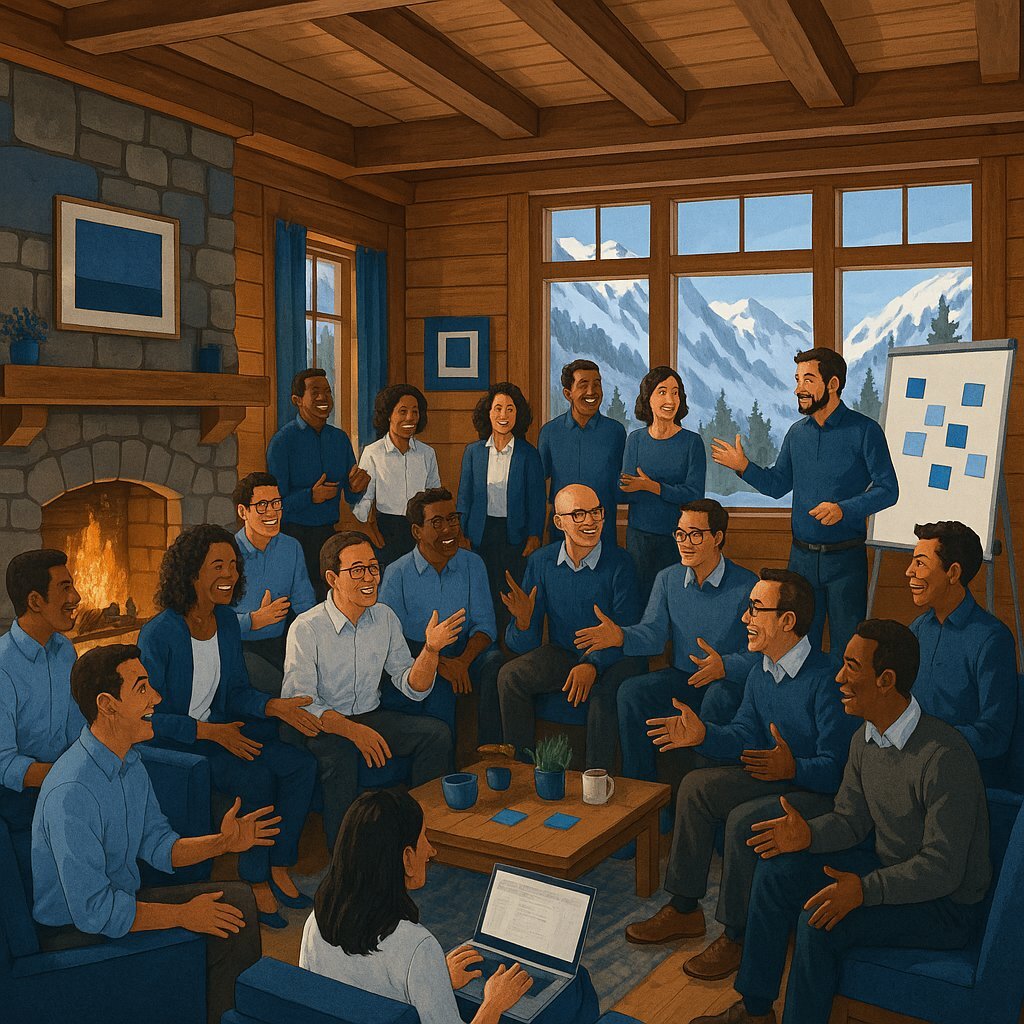
- Unyielding Plans: In a Waterfall world, the plan is king. Once the requirements phase was signed off, changing course was extraordinarily difficult and expensive. A single, late-stage change could invalidate months of work, causing massive budget overruns and delays. This created a system that actively punished learning and adaptation.
- Customer as a Stranger: The customer was deeply involved at the very beginning to define requirements and at the very end to receive the finished product. In the many months or even years in between, they were effectively locked out of the process. This created an enormous risk of a disconnect between the product being built and the customer's real, evolving needs.
- Delayed Value and Hidden Risk: No working software—no tangible value—was produced until the project was nearly complete. This meant that fundamental flaws in design, misunderstandings of requirements, or critical bugs were often discovered only after 100% of the budget had been spent, making them exponentially more expensive and time-consuming to fix.
It is crucial to understand that the gathering at Snowbird was less about codifying a new, rigid process and more about defining a new professional culture. The Manifesto's authors were reacting against a mindset—a bureaucratic system that valued adherence to process over the creative problem-solving of the very people hired to do the work. The document they produced was not a technical specification but a declaration of values, a philosophy centered on trust, collaboration, respect, and putting people first—what signatory Robert C. Martin jokingly called the "mushy stuff". This focus on culture is why the very first value they declared prioritizes "Individuals and interactions over processes and tools".
Their choice of the word "Agile" was also a deliberate strategic move. The preceding term for these adaptive approaches was "lightweight methods," a name some felt implied a lack of seriousness or discipline. By christening their movement "Agile," they rebranded the philosophy with a term that evokes speed, responsiveness, and adaptability—all critical strategic capabilities for any modern business.
The Agile Manifesto Explained: Your Guiding Principles for Modern Development
The Manifesto itself is elegantly simple. It begins with a statement of purpose: "We are uncovering better ways of developing software by doing it and helping others do it." It then lays out four core values that establish a clear hierarchy of priorities for any team seeking to be agile. For an executive, understanding these values is key to understanding the business logic behind the movement.
The Four Core Values, Demystified for the C-Suite
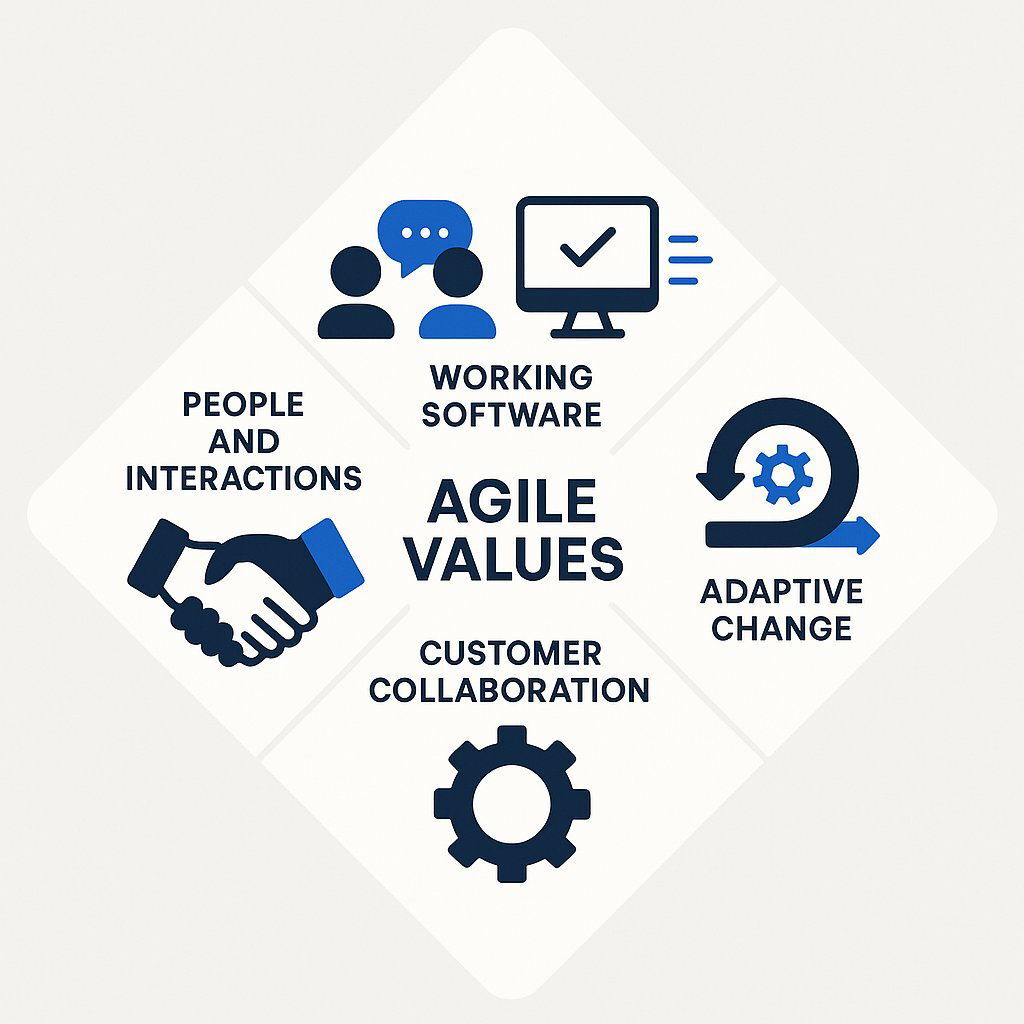
- Individuals and interactions over processes and tools: This means that the most valuable asset in any complex project is a team of motivated, talented people communicating effectively. While processes and tools are necessary, they should serve the team, not constrain it. For a business, this translates to faster problem-solving, greater innovation, and higher employee morale, as it empowers the experts to do their best work.
- Working software over comprehensive documentation: This value prioritizes the delivery of tangible, functional products over spending months creating exhaustive documentation that is often outdated the moment it's written. A working product that a customer can see, touch, and react to is the best way to get feedback and ensure the project is on track. This is about delivering demonstrable ROI early and often, rather than just reports.
- Customer collaboration over contract negotiation: This is a fundamental shift from a transactional relationship to a partnership. The goal is not to rigidly enforce the fine print of an initial contract, but to work continuously with the customer to build the best possible solution that meets their evolving business needs. This collaborative approach dramatically de-risks a project by eliminating the guesswork and ensuring the final product delivers maximum value. At Baytech Consulting, this value is the bedrock of our client relationships. We believe a successful project is a partnership, not a transaction. We build collaborative feedback loops into our process to ensure the software we build is precisely what your business needs to win, even as market conditions change.
- Responding to change over following a plan: In today's dynamic market, the ability to pivot based on new customer feedback, competitive moves, or technological shifts is a primary competitive advantage. A rigid, unchangeable plan is a liability. This value enshrines adaptability as a core principle for success.
It's vital to note the Manifesto's final line: "...while there is value in the items on the right, we value the items on the left more". This nuance is the key to a successful Agile implementation. Agile is not an excuse for chaos; it is not anti-process, anti-tool, anti-documentation, or anti-planning. It is about making intelligent, value-driven trade-offs. When faced with a choice, a truly agile team will always prioritize the items on the left. For an executive, this means shifting the question from "Did your team follow the plan?" to "Did your team make a smart decision to deviate from the plan to better serve a customer need?"
The Twelve Supporting Principles for Business Impact
Backing these four values are twelve supporting principles that provide more specific guidance. Rather than a dry list, they can be grouped into themes that highlight their business impact :
- Focus on Customer Value & Speed: The highest priority is satisfying the customer through the early and continuous delivery of valuable software. This is measured by frequently delivering working software, which is the primary measure of progress.
- Embrace Change & Simplicity: Agile processes welcome changing requirements, even late in development, harnessing change for the customer's competitive advantage. This is balanced by a focus on simplicity—the art of maximizing the amount of work not done.
- Empower Teams & Foster Excellence: This theme is the most comprehensive, covering principles about building projects around motivated individuals, fostering self-organizing teams, promoting sustainable development paces, and maintaining a continuous focus on technical excellence. It recognizes that the best results come from empowered, respected, and highly skilled teams that are given the autonomy to determine the best way to achieve their goals and are encouraged to regularly reflect on how to improve.
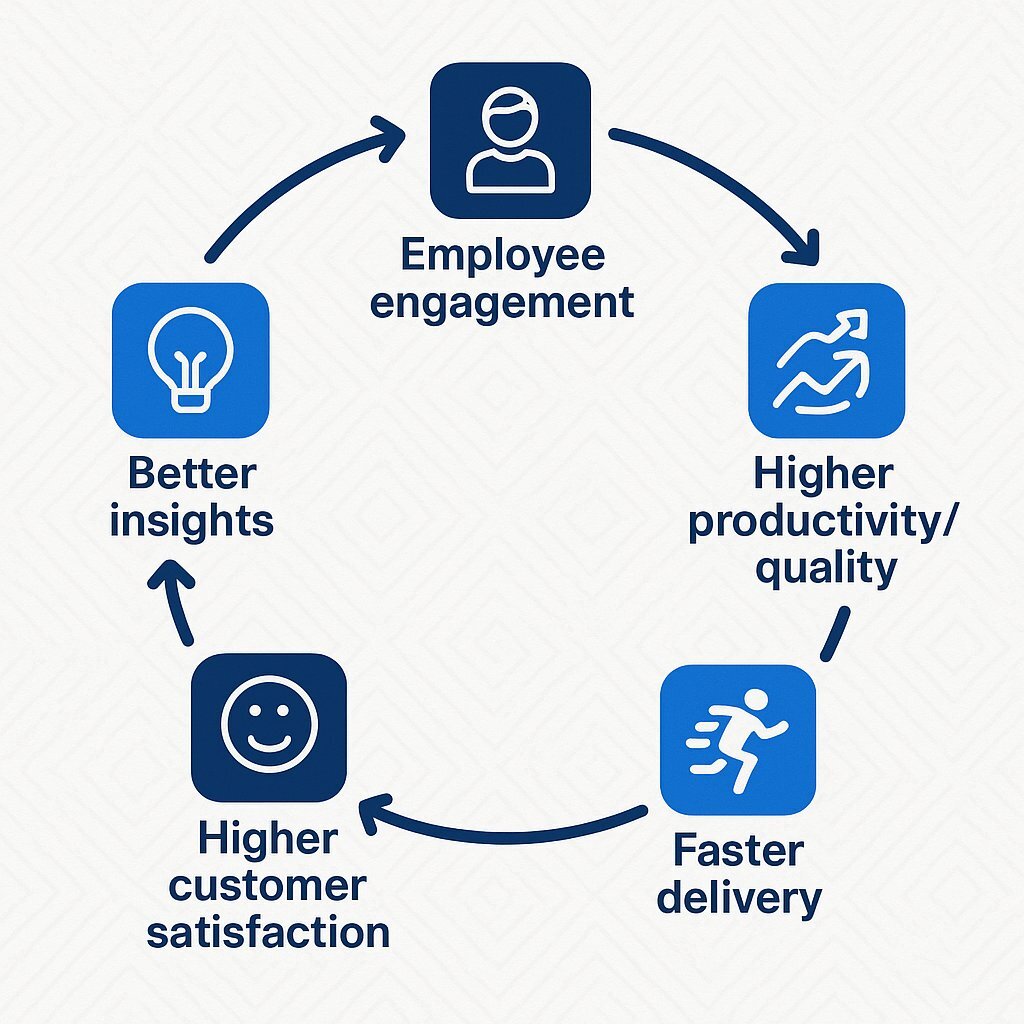
Taken together, these values and principles reveal that Agile is, at its core, a powerful risk-management framework. Traditional development models concentrate nearly all the project risk at the very end. By delivering working software in small, frequent increments, collaborating constantly with the customer, and building in mechanisms to adapt to change, Agile distributes and mitigates risk throughout the entire project lifecycle. It systematically reduces the three biggest threats to any software investment: the risk of building the wrong product, the risk of building a low-quality product, and the risk of delivering value too late to matter.
Is It a Specific Process? Decoding the Agile "Umbrella"
One of the most common and costly misconceptions in the business world is that "Agile" is a specific, singular methodology. It is not. The Agile Manifesto is a philosophy—a set of guiding values and principles that act as a "north star" for development teams. The specific, concrete ways to
implement that philosophy are called frameworks or methodologies.
Think of it as a hierarchy:
- Philosophy: The Agile Manifesto (The "Why" and "What")
- Framework: Scrum, Kanban, etc. (The "How")
- Practices: Daily stand-ups, sprints, visual boards (The "Actions")
Understanding this distinction is critical for any leader. Choosing to "be Agile" is a strategic decision about culture and priorities; choosing a framework is a tactical decision about implementation. The two most dominant frameworks in the industry today are Scrum and Kanban.
Scrum: The Framework for Rhythmic Value Delivery
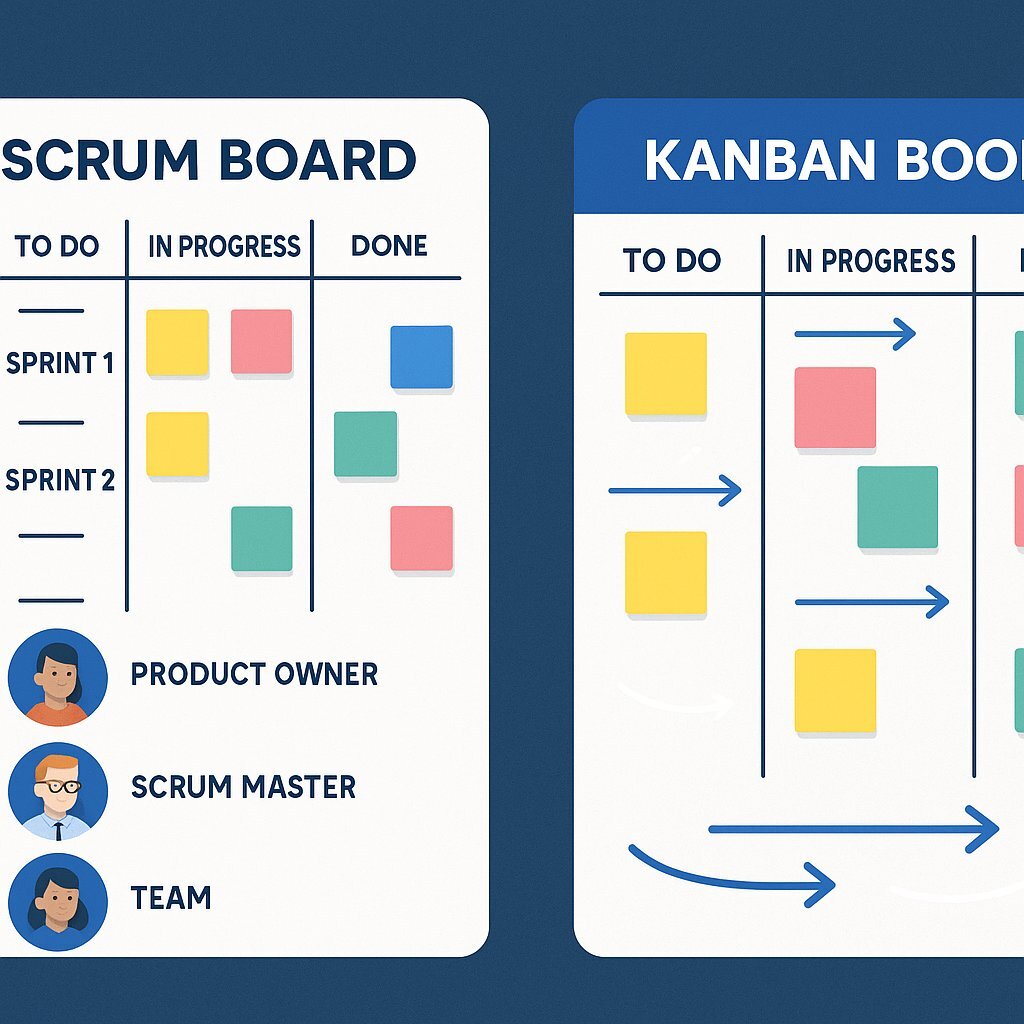
Scrum is a structured yet flexible framework designed for tackling complex projects. It is the most popular Agile framework, used by 87% of Agile teams. It organizes work into a series of rhythmic cycles, providing predictability and regular opportunities for feedback. Its key components, in business terms, are:
- Sprints: These are the heartbeat of Scrum. They are short, time-boxed periods, typically one to four weeks long, during which the team works to complete a set amount of work. Each sprint is like a mini-project that results in a potentially shippable increment of the product. This iterative cycle ensures that tangible value is being created and demonstrated on a regular, predictable cadence.
- Roles: Scrum defines three specific roles: the Product Owner , who represents the business and the customer, and is responsible for prioritizing the work; the Scrum Master , who acts as a coach and facilitator to ensure the team follows the process and removes any impediments; and the Development Team , a self-organizing group of professionals who do the work of building the product.
- Ceremonies: Scrum prescribes a series of regular meetings, or "ceremonies," that create built-in feedback loops for inspection and adaptation. These include Sprint Planning (deciding what to build), the Daily Scrum (a short daily sync-up), the Sprint Review (demonstrating the completed work to stakeholders), and the Sprint Retrospective (reflecting on how to improve the process).
Kanban: The Framework for Continuous Flow
Kanban is a highly visual workflow management method that originated in manufacturing. It is less prescriptive than Scrum and focuses on optimizing the continuous flow of work rather than working in fixed iterations. Its core tenets are:
- Visual Board: The central tool of Kanban is a board that visualizes every piece of work as it moves through various stages (e.g., Backlog, Design, In Progress, Testing, Done). This creates radical transparency, allowing everyone to see the status of work and identify bottlenecks in real-time.
- Continuous Flow: Unlike Scrum's sprints, there are no fixed start or end dates for a cycle. Work items are "pulled" into the next stage by team members as they have the capacity. This means features can be released the moment they are ready, rather than waiting for the end of a sprint, making it ideal for teams that need to respond to changing priorities rapidly.
- Work-in-Progress (WIP) Limits: A key discipline of Kanban is to limit the number of tasks that can be in any one stage at a time. This simple rule prevents teams from becoming overloaded, improves focus, and exposes process inefficiencies by making bottlenecks immediately visible.
Understanding the difference between philosophy and framework is where theory meets execution. At Baytech Consulting, our Rapid Agile Deployment model is built on mastering the Scrum framework. We use structured, time-boxed sprints to turn the flexible philosophy of Agile into a high-velocity engine for delivering working software. This disciplined approach ensures that your project maintains momentum, delivers predictable value, and gets a functional product into your hands—or your customers'—faster.
To help clarify these distinctions, the following table compares the traditional Waterfall approach with the two most popular Agile frameworks.
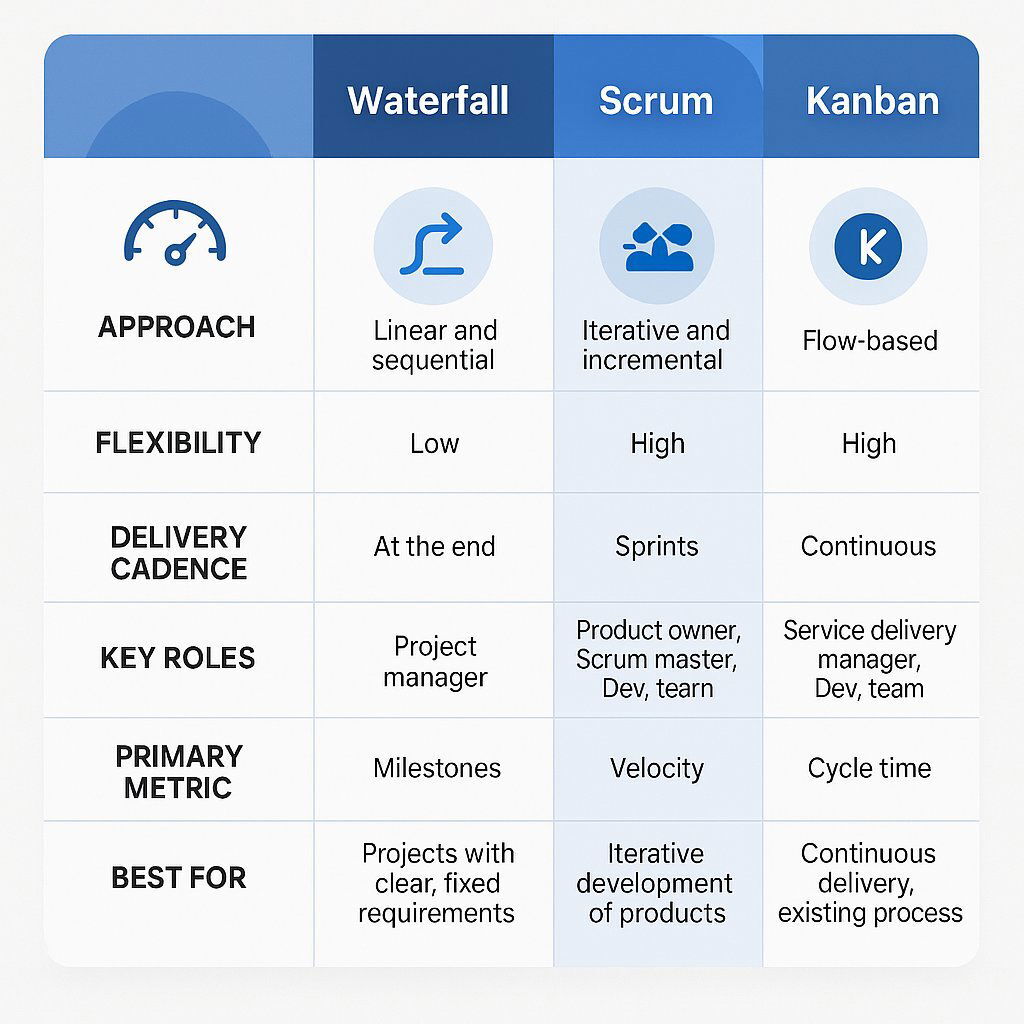
| Feature | Waterfall (Traditional) | Scrum (Agile Framework) | Kanban (Agile Framework) |
|---|---|---|---|
| Approach | Linear, sequential phases | Iterative, time-boxed sprints (1-4 weeks) | Continuous flow |
| Flexibility | Low; changes are difficult and costly | High; changes are incorporated between sprints | Very High; priorities can change in real-time |
| Delivery Cadence | Single delivery at the end of the project | Incremental delivery of working software each sprint | Continuous delivery as tasks are completed |
| Key Roles | Project Manager, Business Analyst, etc. | Product Owner, Scrum Master, Development Team | No prescribed roles; focuses on the team |
| Primary Metric | Plan conformance (on time, on budget) | Velocity (work completed per sprint) | Cycle Time (time to complete one item) |
| Best For | Projects with fixed, well-understood requirements (e.g., construction) | Complex projects with evolving requirements where regular delivery is key | Projects focused on continuous improvement and managing operational workflow |
Data sourced from.
The Bottom-Line Impact: How Agile Practices Drive Tangible Business Results
While the philosophy of Agile is compelling, its explosive, decades-long adoption across industries is rooted in one simple fact: it delivers superior business results. For executives, the decision to embrace Agile is not an act of faith but a data-driven investment in performance, speed, and quality. The evidence, compiled from extensive research by leading consulting firms and industry analysts, is overwhelming.
A Quantifiable Advantage Across the Board
When organizations successfully transition from traditional methods to Agile ways of working, the impact is felt across every key performance indicator.
Accelerated Time-to-Market & Revenue: In a competitive landscape, speed is a weapon. Agile provides a structural advantage in getting value to customers faster. A Boston Consulting Group (BCG) study found that Agile projects achieved a 55% reduction in time-to-market compared to Waterfall projects. In a dramatic example, a large wealth management firm used Agile to go from a product idea to a national launch in just
five months —a task that had previously taken 15 to 18 months, representing a three- to four-fold increase in speed to revenue. This is why "accelerate time to market" is the number one reason companies adopt Agile, cited by 52% of organizations.
Improved Financial Performance & Efficiency: Agile is not just about going faster; it's about operating more efficiently and improving the bottom line. A landmark McKinsey study on agile transformations found they typically delivered around 30% gains in efficiency and operational performance . Another McKinsey report confirmed a
20-30% improvement in overall financial performance for organizations that successfully transform. This is driven by factors like reduced rework and better resource allocation. A financial services company analyzed by BCG found that Agile projects
lowered total project costs by as much as 25% .
Enhanced Product Quality & Reduced Risk: The continuous feedback loops and integrated testing inherent in Agile practices lead to a dramatic improvement in product quality. The same financial institution studied by BCG discovered that products built with Agile had 50% fewer high-severity defects after release than those built with Waterfall. Research has quantified this even further, showing that teams practicing "Full Scrum" have
250% better quality (as measured by defect density) than teams that don't follow disciplined estimation practices.
Increased Customer & Employee Satisfaction: Agile's focus on collaboration and empowerment creates a more engaging and effective work environment. McKinsey's research also points to an average 30% gain in both customer satisfaction and employee engagement following an agile transformation. BCG found a similar
30% boost in employee engagement , with the percentage of team members who "strongly agreed" they were excited about their work stabilizing at an impressive 90%. This is because Agile aligns teams directly with business needs (a benefit cited by 54% of practitioners) and fosters intense collaboration (cited by 69%).
The following chart summarizes these powerful, data-backed outcomes.
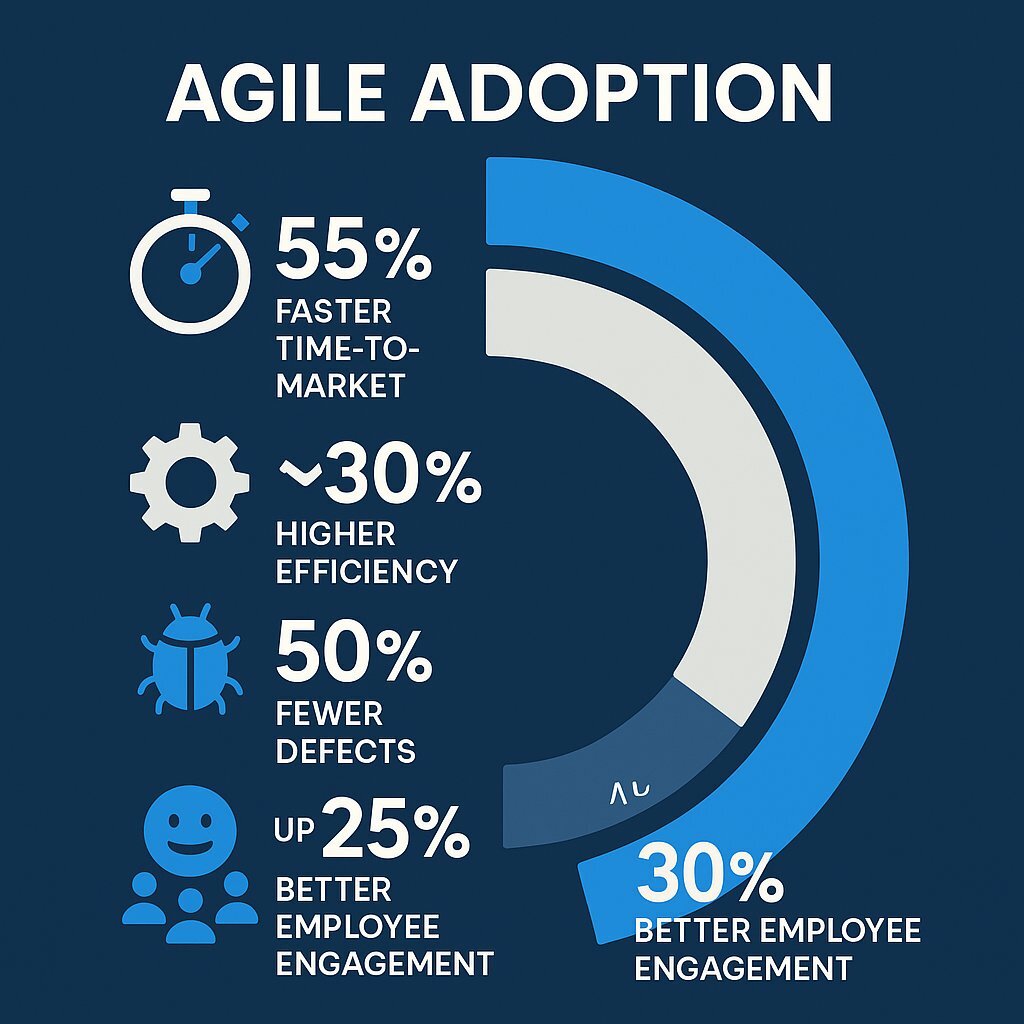
| The Agile Advantage: Quantified Performance Gains | Percentage Improvement |
|---|---|
| Time-to-Market | Up to 55% Faster |
| Productivity & Efficiency | ~30% Improvement |
| Product Quality | 50% Fewer Defects |
| Project Cost | Up to 25% Reduction |
| Employee Engagement | 30% Boost |
| Sources: Boston Consulting Group (BCG), McKinsey & Company |
These incredible results are not automatic. Simply adopting Scrum ceremonies or putting up a Kanban board does not guarantee a 30% boost in efficiency. The difference between a failed Agile adoption and a transformative one lies in expert execution and intelligent adaptation. This is the core of Baytech Consulting's Tailored Tech Advantage . We don't impose a rigid, off-the-shelf Agile process. Instead, we start by deeply understanding your unique business goals, your team's existing culture, and your specific project challenges. We then adapt and tailor our Agile practices to fit your context, ensuring the process serves your business outcomes—not the other way around. This bespoke approach is how we turn the promise of Agile into measurable ROI for our clients.
The interconnectedness of these benefits creates a powerful virtuous cycle. Higher employee engagement leads directly to better productivity and a greater commitment to quality. Delivering a high-quality product to market faster generates earlier revenue and, just as importantly, earlier customer feedback. This feedback loop allows the team to rapidly iterate and improve the product, which increases customer satisfaction. Happier customers are more loyal and provide better insights, which in turn creates a more compelling mission for the team, further boosting engagement. This self-reinforcing cycle drives sustainable high performance, transforming the organization into a more resilient and adaptive competitor. The ultimate ROI of Agile is not just delivering one project faster, but building an organization that can consistently win in a volatile market.
Actionable Advice for Executives: Leading Your Own Agile Shift
Embracing Agile is a profound organizational change, and it comes with significant challenges. The data shows that transformations often stumble not because of technology, but because of people and culture. The most cited barriers to success are clashes with the existing company culture (41%), a lack of active leadership participation (42%), general organizational resistance to change (40%), and a fundamental misunderstanding of Agile by business teams (29%).
Successfully navigating this transition requires direct and sustained executive leadership. Here is a playbook for C-suite leaders aiming to make agility a true competitive advantage.
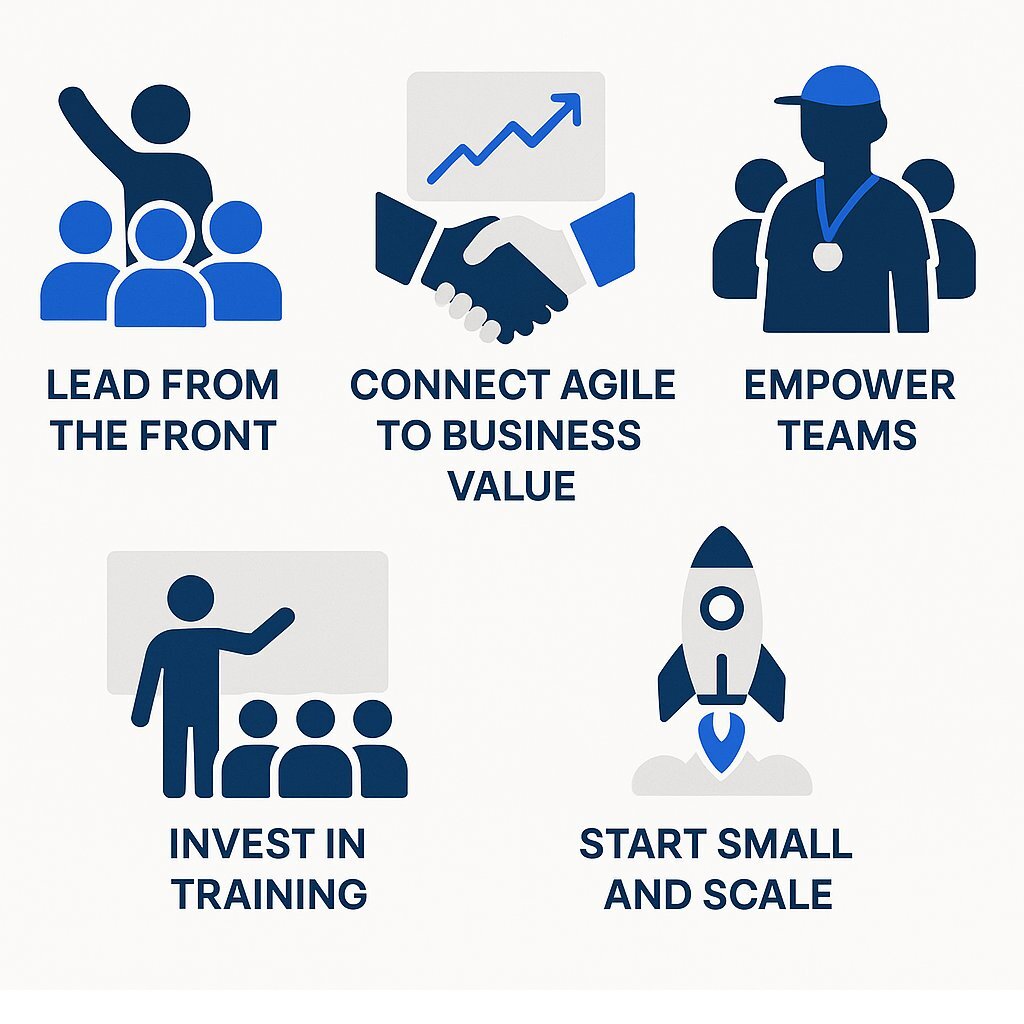
- Lead from the Front (Don't Delegate Culture): An agile transformation is a business-wide initiative, not just an IT project. Its success hinges on the active, visible sponsorship of the senior leadership team. Executives must personally master the core concepts of agility and model the desired behaviors of trust, collaboration, and adaptability. According to McKinsey, ensuring the top team "gets it" before the transformation begins is one of the four key actions that raises the chance of success from 30% to 75%.
- Connect Agile to Business Value (The 'Why'): To get buy-in from across the organization, you must translate Agile principles into the language of business outcomes. Avoid technical jargon like "story points" or "sprint velocity" in the boardroom. Instead, frame the initiative around clear strategic goals: "This new way of working will allow us to launch our new product line a full quarter ahead of the competition," or "This will help us reduce customer churn by 15% by responding to their feedback faster." Frameworks like Objectives and Key Results (OKRs) are powerful tools for linking the day-to-day work of agile teams directly to top-level company priorities.
- Empower and Trust Your Teams (The 'How'): Agile requires a fundamental shift from a "command and control" management style to one of "empower and trust." This can be one of the most difficult cultural changes. The twelfth principle of the Agile Manifesto states: "Build projects around motivated individuals. Give them the environment and support they need, and trust them to get the job done". For leaders, this means evolving from being task-masters to being coaches and facilitators whose primary job is to remove impediments and protect the team from distractions, not to micromanage their work. If you're seeking real-world strategies to empower teams and foster a culture of trust during a digital transformation, take a look at our guide on why manufacturing teams resist software—and how to overcome it.
- Invest in Training and Coaching: Year after year, the top barrier to Agile adoption is a lack of training and knowledge. It is unrealistic to expect teams and, critically, middle managers to intuitively grasp this new way of working. Invest in professional Agile coaching and comprehensive training to build a shared vocabulary and understanding of the principles and practices. This investment is not a cost center; it is a critical enabler of the transformation's ROI.
- Start Small, Prove Value, then Scale: A "big bang" agile transformation across an entire enterprise is incredibly risky. A more effective approach is to start with a single, important pilot project or a "front-runner" team. This allows the organization to learn, adapt the process, and—most importantly—generate a visible, early win. A successful pilot creates internal champions and provides undeniable proof of Agile's value, which helps to overcome skepticism and build the momentum needed for a broader, more successful rollout. To help structure that journey from pilot to scale, you can explore our hands-on executive roadmap for technology adoption in "How Do We Get Started and Integrate AI?"
Conclusion: Make Agility Your Competitive Edge
More than two decades after its creation at a Utah ski resort, the Agile Manifesto remains more relevant than ever. It was born as a necessary rebellion against the slow, risky, and customer-unfriendly software development methods of the past. Today, it provides a proven philosophy for any business that needs to innovate faster, reduce the risk of large-scale investments, and build products in true partnership with its customers.
The fundamental choice facing business leaders is no longer "Agile versus Waterfall." It is "Adaptability versus Rigidity." In a market defined by constant change and disruption, the ability to sense and respond is not a luxury; it is the primary determinant of long-term survival and success.
Understanding the Agile Manifesto is the first step. Translating its principles into real-world results is the next. If you're ready to move beyond the buzzwords and transform your next custom software project into a strategic asset, let's talk. Schedule a no-obligation consultation with Baytech Consulting today. We'll help you assess how our Tailored Tech Advantage and Rapid Agile Deployment model can deliver the specific outcomes your business needs to thrive. For a look at how team empowerment, rapid feedback, and adaptability fuel true competitive advantage in modern digital projects—and why they're the foundation for success in cloud-native architecture as well—see our executive blueprint for agility in the cloud era.
Further Reading
- https://agilemanifesto.org/
- https://www.atlassian.com/agile/advantage/agile-is-a-competitive-advantage
- https://www.atlassian.com/agile/scrum
About Baytech
At Baytech Consulting, we specialize in guiding businesses through this process, helping you build scalable, efficient, and high-performing software that evolves with your needs. Our MVP first approach helps our clients minimize upfront costs and maximize ROI. Ready to take the next step in your software development journey? Contact us today to learn how we can help you achieve your goals with a phased development approach.
About the Author

Bryan Reynolds is an accomplished technology executive with more than 25 years of experience leading innovation in the software industry. As the CEO and founder of Baytech Consulting, he has built a reputation for delivering custom software solutions that help businesses streamline operations, enhance customer experiences, and drive growth.
Bryan’s expertise spans custom software development, cloud infrastructure, artificial intelligence, and strategic business consulting, making him a trusted advisor and thought leader across a wide range of industries.


